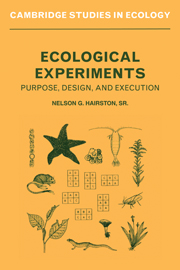Book contents
- Frontmatter
- Contents
- Preface
- Acknowledgments
- 1 Ecological problems and how they are approached
- 2 Minimal requirements of experimental design in ecology
- 3 Trade-offs in ecological experimentation
- 4 Experiments in forests
- 5 Experiments in terrestrial successional communities
- 6 Experiments in arid environments
- 7 Experiments in fresh water
- 8 Experiments in marine environments
- 9 Conclusions to be drawn from field experiments
- References
- Name index
- Subject index
5 - Experiments in terrestrial successional communities
Published online by Cambridge University Press: 05 June 2015
- Frontmatter
- Contents
- Preface
- Acknowledgments
- 1 Ecological problems and how they are approached
- 2 Minimal requirements of experimental design in ecology
- 3 Trade-offs in ecological experimentation
- 4 Experiments in forests
- 5 Experiments in terrestrial successional communities
- 6 Experiments in arid environments
- 7 Experiments in fresh water
- 8 Experiments in marine environments
- 9 Conclusions to be drawn from field experiments
- References
- Name index
- Subject index
Summary
Introduction
Much of the area that was once forested, especially in the North Temperate Zone, is now either under cultivation or undergoing some stage of secondary succession. Such areas are more convenient for experimentation than forests themselves, because the vegetation is low enough to be accessible. A perusal of the table of information amassed by Schoener (1983) on field experiments reveals the large number of experiments that have been conducted in fields, meadows, or pastures – sixty-six species or groups of plants involved, compared with thirty-eight in forests – and it should be recognized that the experiments in pine forests reported by Korstian and Coile (1938) (Chapter 4) were in a late stage of succession.
The distinction between mature and successional stages is not trivial, as a comparison of the results reported by Schoener (1983) reveals: Of the 38 species in forests, 33 showed competition “always,” 2 “sometimes,” and only 3 “never.” In contrast, of the 66 species in fields, meadows, or pastures, less than half (29) showed competition “always,” 25 “sometimes,” and 12 “never.” The difference is highly significant statistically (p < .001). Despite the lower frequency of interspecific competition among plants in successional locations, the descriptions of experiments follow the same order as in Chapter 4, because that procedure will permit comparisons of the interactions causing the differences between forest communities and successional communities. Excellent experiments have been conducted in deserts and other arid areas; they are deferred to Chapter 6, because many of the interspecific relationships are unique to such habitats.
- Type
- Chapter
- Information
- Ecological ExperimentsPurpose, Design and Execution, pp. 128 - 169Publisher: Cambridge University PressPrint publication year: 1989

